Theatergoers line up at a taxi stand.
Photos taken July 27, 2018, 10:58 PM, at the Kennedy Center for the Performing Arts, Washington, DC, after an evening performance of the musical “Hamilton.”
.
.
.
.
In 2017 I was able to place a few American artworks into the collections of five museums.
1. The Pennsylvania Academy of the Fine Arts accepted my gift of a pencil drawing by Arthur B. Carles (1882-1952) that I had recently spotted and bought at auction. Carles was an early 20th century Philadelphia modernist who studied and later briefly taught at the Pennsylvania Academy. This small drawing (9.5″ x 5″), stamped on the verso with his estate stamp, is a self-portrait. The relatively young artist presents himself as a man of confident demeanor. His expression is open, inquisitive, wry, and ever-observant.
.
.
2. The Woodmere Art Museum, also located in my hometown of Philadelphia, accepted into its collection two paintings. Each is a 19th century work with a Philadelphia connection. I had the Woodmere museum specifically in mind when I came across them at an auction sale early in 2017. I was familiar with Museum’s motto: “Telling the Story of Philadelphia’s Art and Artists,” and thought these would fit right in.
The first work is by William Thompson Russell Smith (1812-1896. It is titled on the verso, “Rockhill, Branchtown [Philadelphia]” Dating from 1844, this an oil on canvas on board, 16″ by 23 3/4 inches in size. A 19th-century inscription on the verso indicates the house and grounds depicted were Russell Smith’s home from 1840 to 1854. Additional labels attached to the reverse show its provenance includes two commercial galleries, Alexander Gallery and Questroyal Fine Arts, both located in New York City. The provenance very likely includes the Cooley Gallery, as this painting appears to be the same work described in a fact sheet prepared by that Connecticut dealer.
The mother and two children who are pictured on the lawn are almost certainly the artist’s wife, Mary Priscilla Wilson, and their son and daughter — Xanthus Russell Smith born in 1839 and Mary Russell Smith born in 1842. Xanthus and Mary both became painters.
.
.
The other work accepted by the Woodmere Museum is a plein air oil sketch on wood panel by Frank Walter Taylor (1874-1921). Entitled “Along the Seine,” it dates from the late 1890s and is a mere 5″ x 7″ in size. Taylor began studies at the Pennsylvania Academy of Fine Arts in the mid-1890s, then continued his education in Paris on a traveling scholarship. In 1898 he returned to Philadelphia, where he became a prominent illustrator.
.
.
3. The Westmoreland Museum of American Art received a landscape painting of Western Pennsylvania by Norwood Hodge MacGilvary (1874-1949). Titled “The Optimist,” this oil on canvas is 25″ x 31″ and undated, although a label on the verso from the Carnegie Institute in Pittsburgh lists the artist’s address as “College of Fine Arts, Carnegie Tech.” — suggesting the painting dates to the period 1921-1943 when MacGilvary taught painting at that school. A brief biography of the artist can be found here. Additional photos of details of the painting are available here. The gift is reported on page 6 of the museum’s January-April 2018 Newsletter, here.
.
.
4. The American University Museum at the Katzen Art Center, in Washington DC, accepted my gift of a painting by Hilda Shapiro Thorpe (1919-2000). This untitled color block abstraction, dating from the 1960s, relates to the work of her fellow artists of the Washington Color School produced during that exciting decade. This is an oil on canvas, 48.5″ x 26,” signed by the artist in marker on the stretcher as “Hilda Shapiro”
.
.
5. Columbia University Art Collection, Avery Art Properties, accepted my gift of two paintings by artists who were active in New York City in the 1980s and 1990s.
The first is a work by Peter Nagy (American, b. 1959), artist and co-founder of Gallery Nature Morte which operated during the height of the East Village art scene in the early 1980s. Titled “Static Fades,” this oil and acrylic on canvas is 36″ x 36″.
.
.
The other painting is by Vernon (“Copy”) Berg (American, 1951-1999). An oil on canvas measuring 20 inches square, it is untitled but dated 1990 on the verso. Today, Berg is mostly known for his importance in the history of the gay liberation movement, yet his artwork deserves greater exposure and attention than it has received. A 1995 NY Times profile of the artist is available, here.
.
.
This painting is one of the few canvases completed by Berg in his final years, a period when his health and strength declined due to complications from AIDS and he shifted his attention to small drawings and watercolors. It’s a wild and interesting piece.
The painting appears inspired by a daydream — or a hallucination. The setting is an unfurnished interior space with a high ceiling, as found in a museum or commercial art gallery. That it may be a picture gallery is suggested by Berg’s insertion of four, incompletely-drawn black rectangles. On the left side, two largely intact rectangles, each of which cuts into a portion of the overall tumultuous activity, look like they are instruments to corral and compose a portion of the action, to create independent pictures out of a chaotic whole. The effect is similar to the way a photographer selects and circumscribes a scene through the camera’s view-finder. Or the way an artist edits a broad vista via exclusion, testing solutions by placing their hands in this configuration:
Could the painting be a commentary on the art-making process, a summary of the fraught journey that leads from an artist’s initial visualization to a final gallery exhibition of completed work? Are we looking at an imagined exhibition of Berg’s own pieces — the ones he was struggling to finish — magically come to life?
What’s certain is that the figures will not be fenced in. The painting is crowded with animated beings drawn in a cartoon fashion, similar to Berg’s rendering of cats in Cat Tango (1988, oil on canvas, 72″ x 60″), dinosaurs in Dinosaur Conversation (1990, watercolor on paper, 9″ x 7″), and two fantastic beings in A Centaur and An Angel (1993, watercolor and crayon on paper, 14.5″ x 14.5″) (three of 36 Berg artworks found here).
Some of the figures in this untitled work are grounded, others hover in mid-air where they cavort and argue and couple closely. There is discord. I’m struck by how the scene envisioned by Berg within a tilted, vertiginous space, is reminiscent of the physical interaction imagined many decades before in an early Philip Guston painting:
.
Early in Lin-Manuel Miranda’s stage musical, Hamilton, during a scene set on the streets of Colonial New York City, the Schuyler Sisters — Angelica, Eliza (and Peggy) — sing an exuberant song in praise of the city. Among the song’s lyrics are these joyful words:
“[H]ow lucky we are to be alive right now! History is happening in Manhattan and we just happen to be in the greatest city in the world!”
The three young ladies dare any of their listeners to deny that theirs is indeed the “greatest city.” The challenge they issue to dissenters is a simple instruction, repeated over the course of the song a total of 16 times:
“Look around!”
Over two centuries later, look around is still good advice to anyone who wants to experience New York City in all of its fullness. I would add one amendment to the guidance of the three sisters. If you find yourself on the streets of present-day NYC, remember this:
There are moments when looking around also calls for you … to look up!
.
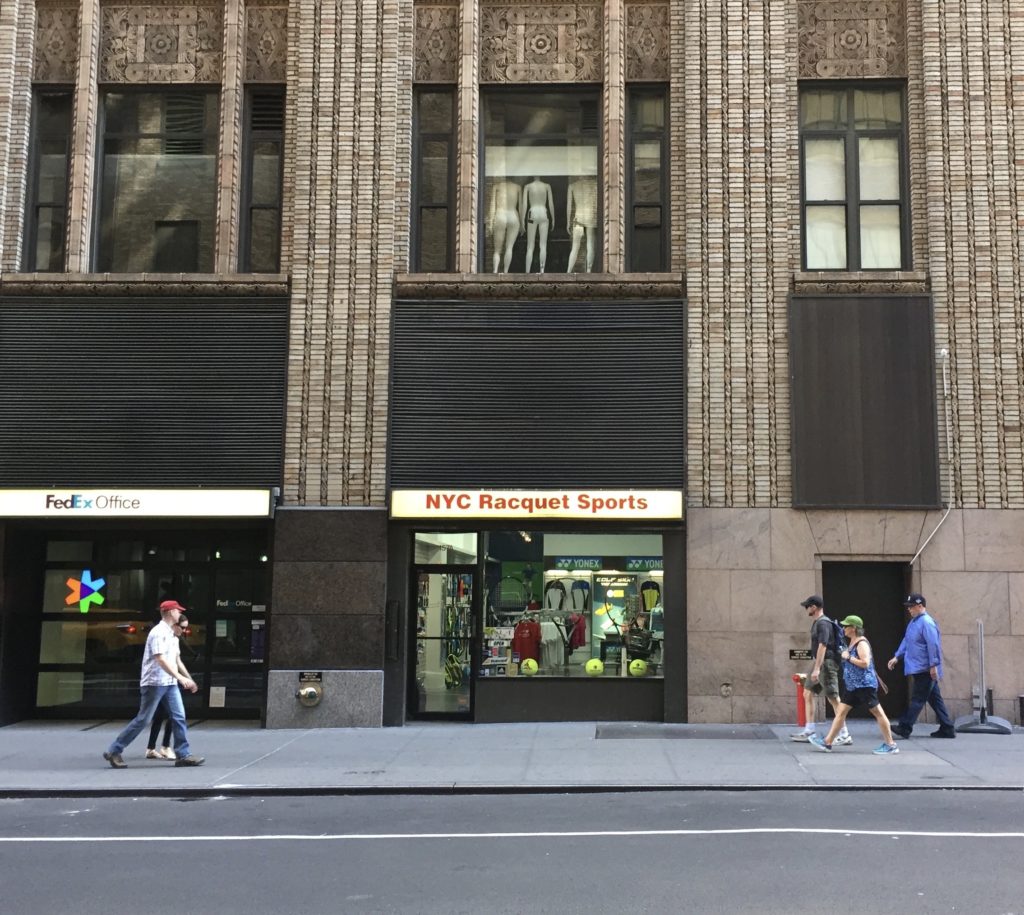 New York City, 157 W. 35th St., September 23, 2017 at 11:45:33 AM
New York City, 157 W. 35th St., September 23, 2017 at 11:45:33 AM
.
.
The 2017 Robert Rauschenberg restrospective at the Museum of Modern Art (Robert Rauschenberg: Among Friends) included a notorious early work entitled Erased de Kooning Drawing (1953). As explained in information supplied on the museum wall, Rauschenberg’s idea was to test “whether a drawing could be created out of erasing.”
Here are my initial photos of the piece and related wall text.
.
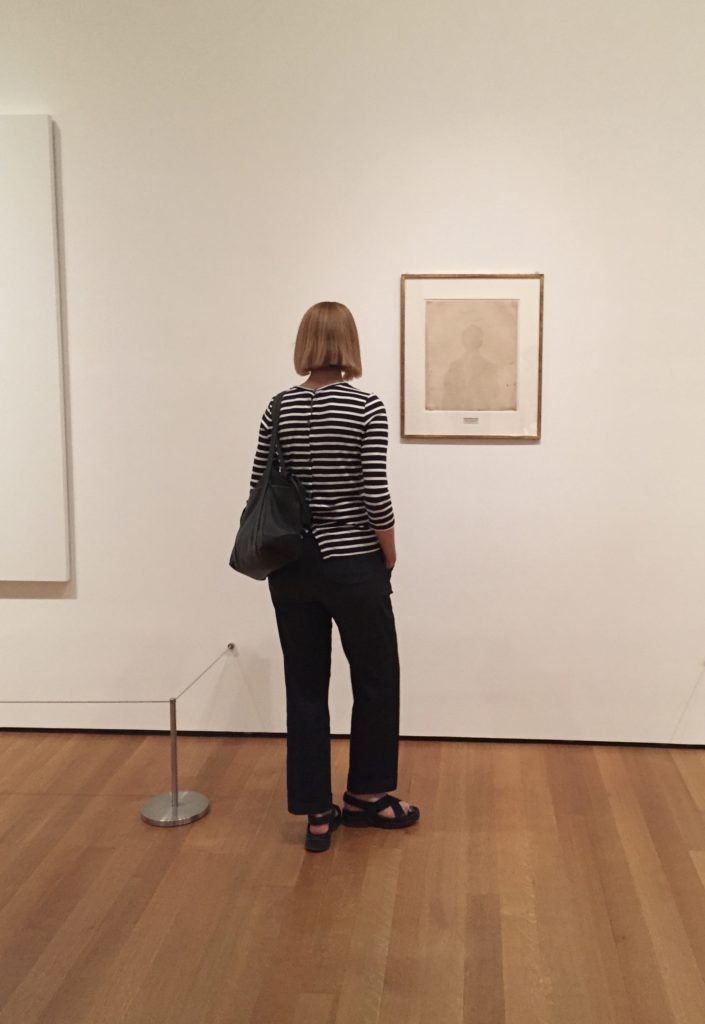 Rauschenberg, Erased de Kooning Drawing, MOMA, June 15, 2017, 3:37:08 PM
Rauschenberg, Erased de Kooning Drawing, MOMA, June 15, 2017, 3:37:08 PM
.
As I waited to get a closer, one-on-one encounter with the picture itself, I began to see why capturing a clean shot of the erasing — a clean shot at nothing — was impossible. The frame’s glazing reflected objects elsewhere in the room, such as a display case in the middle of the gallery, a red EXIT sign on the opposite wall, and visitors as they came and went. Viewers who halted directly in front of the drawing were met with reflections of themselves. They became part of the artwork. This phenomenon, while probably not in Rauschenberg’s plan for this particular piece, is satisfyingly consistent with the participatory element of his artistic practice.*
So I like to think Rauschenberg would have welcomed me occupying his picture, briefly, as a ghost-like silhouette:
.
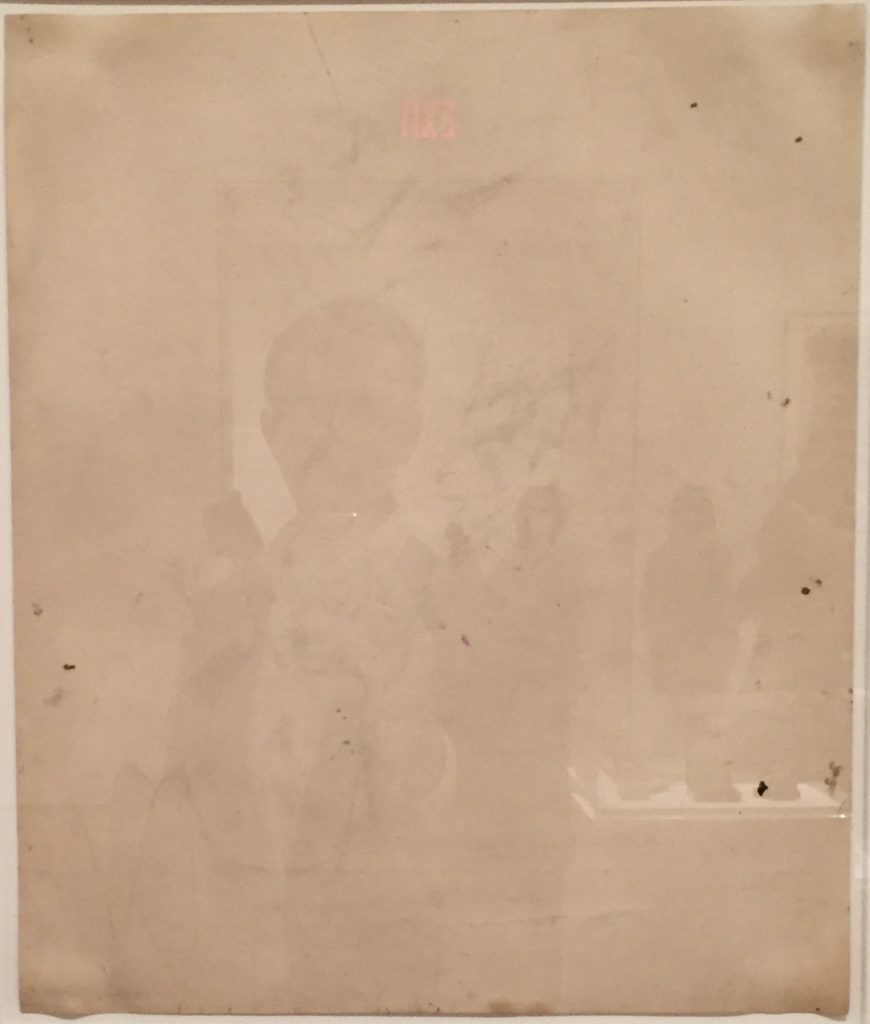 Rauschenberg, Erased de Kooning Drawing, MOMA, June 15, 2017 at 3:38:30 PM
Rauschenberg, Erased de Kooning Drawing, MOMA, June 15, 2017 at 3:38:30 PM
.
– – – – – – – – –
* For example, Rauschenberg’s 1951 White Paintings and their subsequent incarnations were meant to be receptive surfaces registering light and shadow effects generated within their surrounding space — including shadows of viewers. Numerous times the artist included mirrors and other reflective materials in his Combines, Spreads, and other series, to the same end.
.
.
The best of Edward Hopper’s art never seems dated. While details in each of his paintings and works on paper may disclose when and where it was created, the essence of what Hopper captured — a psychological and emotional truth — is timeless and everywhere. It’s as if Hopper searched for persons and places and then used only poses, tableaux or scenes he knew were bound to recur. Whatever the source of his insight, his perspicacity in this regard is is why his work continues to speak to us today.
Hopper’s insight extended not just to men and women, but to the physical environment as well. The American man-made structures he was attracted to — especially those of the mutating city — remain in form and mood pretty much the same today.
If you seek evidence of this, there’s an easy source at hand.
Call up Google Maps. In the search box enter the name of an American city of your choice. Zoom in to reveal enough of the city’s oldest urban street grid to allow you to invoke the Street View function found in the lower right corner of your screen. Drag and drop the yellow little man icon down upon a street corner. Proceed to “walk” through the neighborhood with a Hopper-inspired intent and gaze.
In the homely example below, I chose to visit Pittsburgh and explore a transitioning residential block. I halted when I came upon a lonely house.
The same as I imagine Hopper did, though in a difference place and time.
.
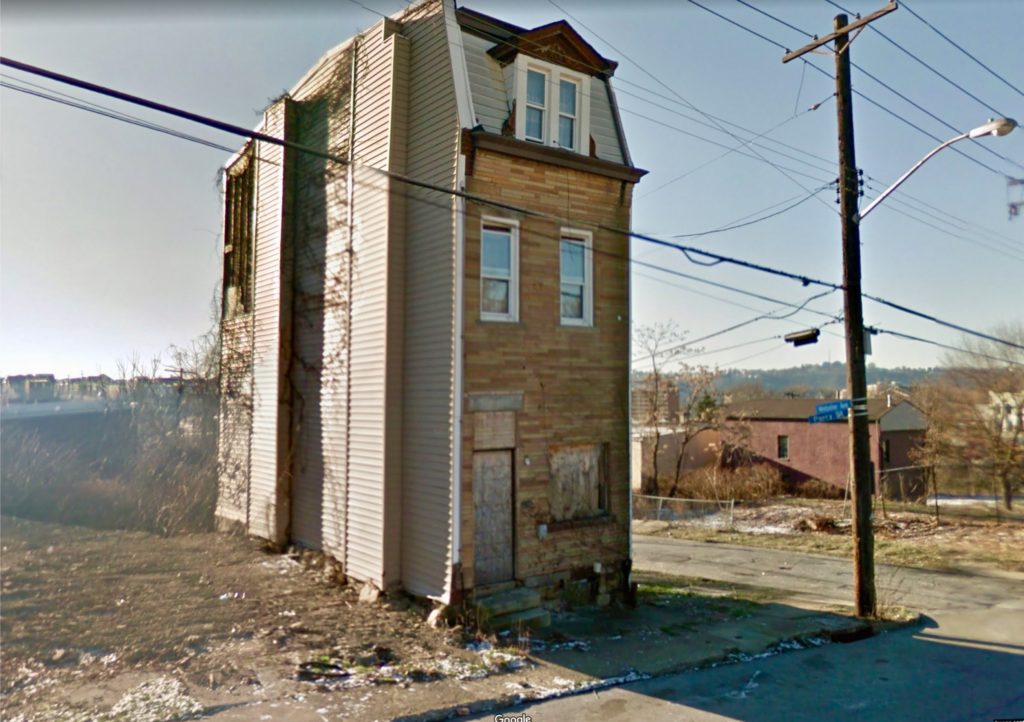 Abandoned House at Webster Ave. and Perry St., Pittsburgh, PA, Jan. 2016 (source: Google Street View)
Abandoned House at Webster Ave. and Perry St., Pittsburgh, PA, Jan. 2016 (source: Google Street View)
.
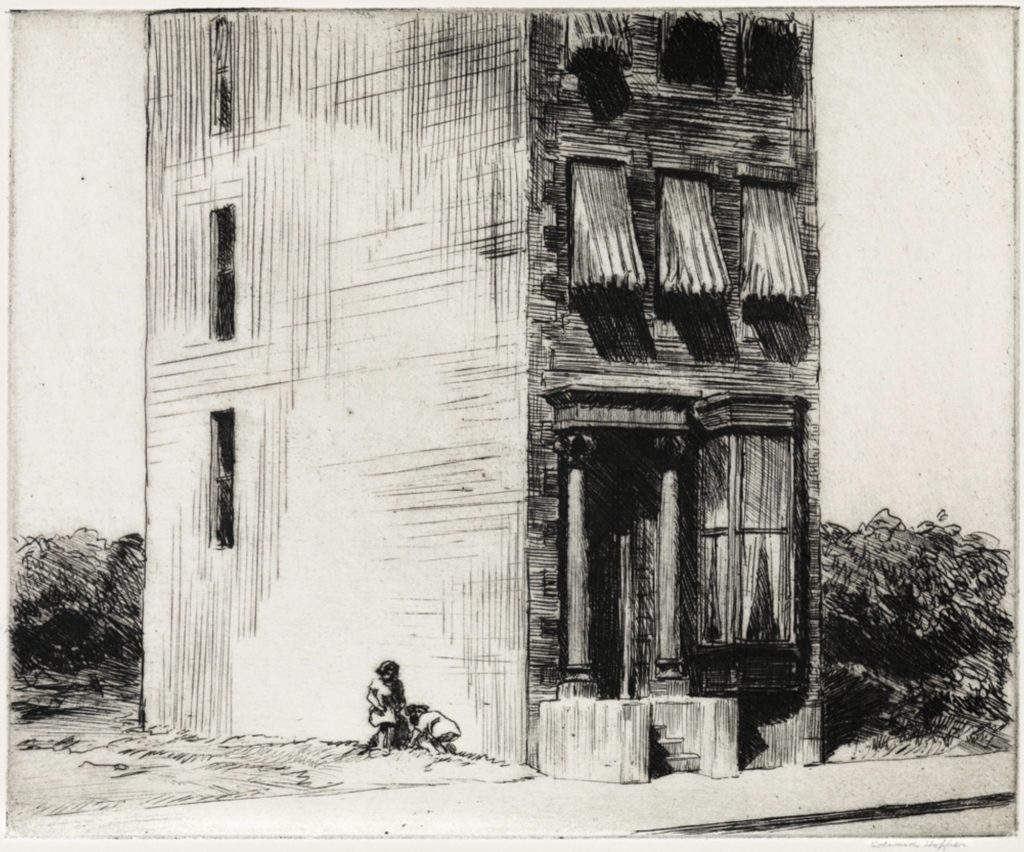 Edward Hopper, The Lonely House, 1923, etching, 8 x 10 inches
Edward Hopper, The Lonely House, 1923, etching, 8 x 10 inches
.
Over the days ahead I want to post a handful of photographs from 2017 I’m especially happy with.
This first one was taken on the afternoon of January 6, 2017, at the Phillips Collection in Washington, DC, during the exhibition, “People on the Move: Beauty and Struggle in Jacob Lawrence’s Migration Series”
.
The central painting on the wall, in front of which a trio of kids have stopped to look and discuss, is Panel no. 58 out of a total of 60 panels in the complete Migration Series. Lawrence’s caption to it is: “In the North the African American had more educational opportunities.”
.
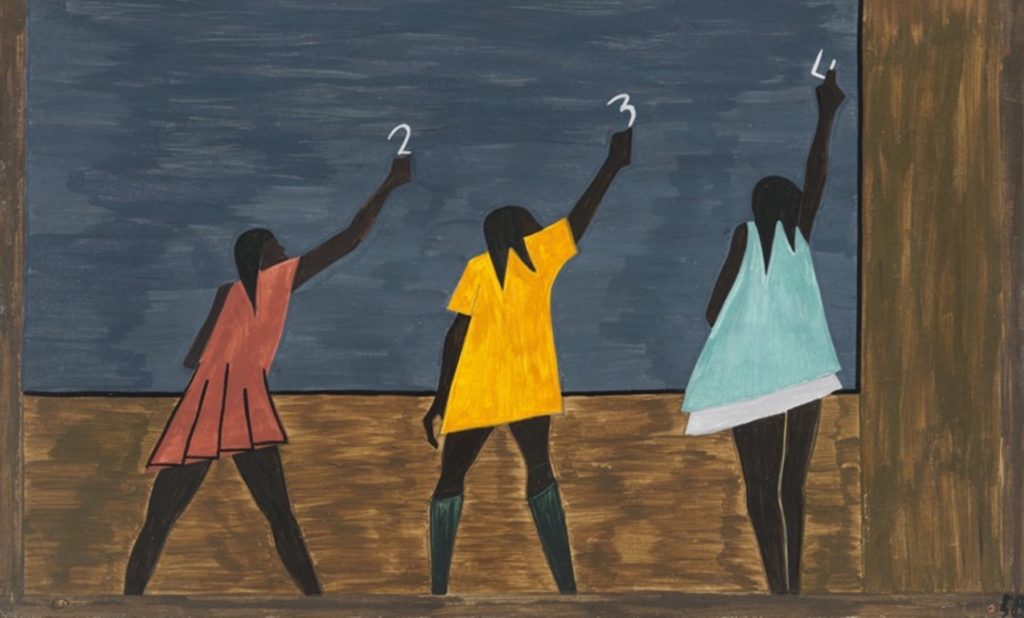 Jacob Lawrence, Migration Series, Panel no. 58, 1940-41. Casein tempera on hardboard, 12 x 18 in. The Museum of Modern Art, New York, Gift of Mrs. David M. Levy
Jacob Lawrence, Migration Series, Panel no. 58, 1940-41. Casein tempera on hardboard, 12 x 18 in. The Museum of Modern Art, New York, Gift of Mrs. David M. Levy
.
The 2015 reopening of the Renwick Gallery in Washington, DC, was celebrated with an exhibition featuring the work of nine contemporary artists. Five women and four men created site-specific installations that occupied and transformed the museum’s refurbished gallery spaces. Over a period of 8 months, visitors found themselves immersed in wonders indeed. Official photographs of the event can seen at the online gallery, here. Below are photos of three of the nine rooms that I took during my visit in April, 2016. Descriptions of the artists’ works quoted below are borrowed from the Renwick Gallery’s wall texts, found here.
Maya Lin, Folding the Chesapeake (installation, 2015)
Gabriel Dawe, Plexus A1 (installation, 2015)
“Dawe’s architecturally scaled weavings are often mistaken for fleeting rays of light. It is an appropriate trick of the eye, as the artist was inspired to use thread in this fashion by memories of the skies above Mexico City and East Texas, his childhood and current homes, respectively. The material and vivid colors also recall the embroideries everywhere in production during Dawe’s upbringing.”
.
Tara Donovan, Untitled , 2014, © Tara Donovan, courtesy of Pace Gallery
“Employing mundane materials such as toothpicks, straws, Styrofoam cups, scotch tape, and index cards, Donovan gathers up the things we think we know, transforming the familiar into the unrecognizable through overwhelming accumulation. The resulting enigmatic landscapes force us to wonder just what it is we are looking at and how to respond. The mystery, and the potential for any material in her hands to capture it, prompts us to pay better attention to our surroundings, permitting the everyday to catch us up again.”
.
.
.
.
Earlier this evening while visiting the National Gallery of Art I saw how smartly the museum has integrated a few of the thousands of American works of art it acquired last year from the defunct Corcoran Gallery of Art (founded 1869, dissolved 2014).
For example, the pinnacle of the Corcoran’s collection of Hudson River School paintings, Niagara (1857) by Frederick Edwin Church (1826-1900), has been given pride of place in this room at the National Gallery of Art — where it has become the painting people invariably stop to admire:
.
.
.
(For a memento of how the painting looked when it used to hang at the Corcoran Gallery of Art, click here.)
A strength of the Corcoran museum, and an element that in my personal experience over the years turned that institution into an enlightening museum of American history as well as a fine museum of American art, was its collection of genre paintings — depictions of everyday life in our nation. Here are four gems belonging to that category, newly huddled in a corner where they are adding vitality to visitors’ experience of the National Gallery of Art.
.
.
The large canvas on the left is a picture I made certain to pay my respects to on dozens of visits (starting in the 1970s) to its former home. Titled A Pastoral Visit, it was painted in 1881 by Richard Norris Brooke (1847-1920). A powerful narrative executed with controlled sentimentality, the painting succeeds in a way that Norman Rockwell — our most beloved genre artist — all too often does not.
On the right side of the photo, the three other paintings that came to the NGA from the Corcoran share Brooke’s ambition and achievement. But these are scenes of more modest scale, with a tone unique to each artist. From left to right: The Tough Story–Scene in a Country Tavern (1837) by William Sidney Mount (1807-1868); Waiting for the Stage (1851) by Richard Caton Woodville (1825-1855); and Leisure and Labor (1858) by Frank Blackwell Mayer (1827-1899), an early political commentary conveyed via posture and dress (while beautifully composed and painted, too).
Now I look forward to the NGA hanging on its walls additional, equally bold works from the Corcoran trove. Two suggestions, if I may: The Longshoreman’s Noon (1879) by John George Brown, and Nearing the Issue at the Cockpit (1879) by Horace Bonham.
.